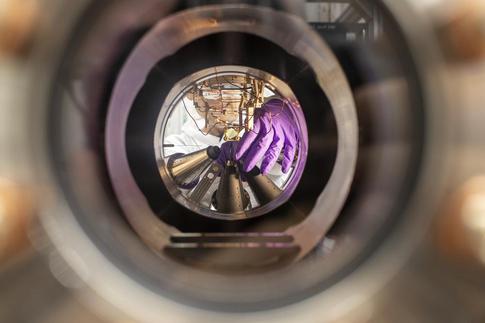XFEL: Mapping out a transient atom
Mapping out a transient atom

A view into the atomic-like quantum systems (AQS) experiment station.The experiment is carried out at the SQS scientific instrument located on the SASE3 soft-x-ray branch of the European XFEL, using the AQS experimental station. Copyright European XFEL
An international team from Germany, Sweden, Russia and the USA, led by scientists from European XFEL, has published the results of an experiment that could provide a blueprint for the analysis of transitions states in atoms and molecules. This would open up new opportunities to gain insights into important processes such as photocatalysis, elementary steps in photosynthesis and radiation damage. It was the very first user experiment carried out at European XFEL’s Small Quantum System (SQS) instrument. The scientists used high-resolution electron spectroscopy to capture a snapshot of the short-lived transient state produced when X-rays punch a hole in the very core of the atomic electron cloud. The results of the study, which was carried out on neon atoms, are the starting point for the analysis of transient states and have been published in Physical Review X.
The extremely short-lived transient state of core-exited neon lasts for just 2.4 femtoseconds. To put a femtosecond in context: a femtosecond is to a second as a second is to about 31.71 million years. “The European XFEL allows us to use a high number of laser pulses per second and high pulse energy. This means we can bring a very high number of photons to the sample, which is crucial to probe such transient atomic states,” explains Tommaso Mazza, the lead author of the paper.
“We used intense X-ray pulses to first remove the electrons from the inner shell, or core, of a neon atom and then used a second photon from the same X-ray pulse to map out the ‘hollow’ atom,” says Mazza. “This is the first time scientists are able to obtain information of the electronic structure of this core-hole transient state by X-ray induced electron spectroscopy, and, more precisely, by measuring the energy of the electrons emitted after the excitation by the second photon while smoothly changing the wavelength of the X-ray pulses,” he adds.
Leading Scientist at SQS Michael Meyer underlines that the results of this paper along with a paper recently published in Science show the outstanding possibility to efficiently control and probe excitations of specific electronic subshells at the SQS instrument. “We can enable atomic or element specific excitations in molecular targets and independently investigate for each atom the influence on the photon-induced molecular dynamics,” he says. Targeting a specific atom in a molecule allows scientists to gain deeper understanding of the behavior of individual building blocks in the molecular assembly under intense irradiation.
